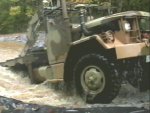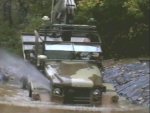Thanks Kenny!
I agree Ryan, but it is for a very short time period and the fan stops doing its job, so there may be a small tradeoff too.
The coolant will help keep the engine warm also.
The only parts that may be above the boiling point of water are the exhaust related ones and they swing from a few hundred degrees to a thousand or more every time the accelerator is depressed.
Cast iron parts will expand and contract together.
On the highway I have seen the engine temp drop 40 or more degrees going down a long hill/mountain (that's the reason for my custom radiator cover, BTW) in less than a minute.
Put a sensitive thermocouple probe next to the engine temp sending unit, there is a plug there, and look at the temp changes on a DVM. You'd be surprised how much and quickly it changes.
Perhaps I'll do the fording experiment over one day with more water and look at some details like this.
Look around, it's very hard to find a place to ford your truck, so this is probably not a critical issue for most of us anyway.
Aside from the engine, the warm air in the axle housings will cool off and there may be some condensation because of this. The breather valves are essentially one-way valves designed to let expanding air out. When the air cools it contracts and fights the breather valves. My solution here was to extend the vents to a central point under the hood high on the fire wall. They can also be pressurized.
It's an iteresting question and I don't have any specific answeres at the moment other than the general ones stated.




